Bavarian Raitt Translation
What follows is the translation into English of the German manuscript Genealogie und Stammbuch der Familie Raitt bis 1683 (Genealogy and Family Register of the Raitt Family until the Year 1683.) that I discovered in the Bavarian State Library. The 17th century German handwriting was transcribed into old German by Sabine Lenthe, and then this was translated into English (via modern German) by Elke Hedstrom. The pages in old Latin handwriting were translated by Markus through the auspices of Transcription Services Ltd. I am very grateful for their assistance in making this ancient, illuminating and possibly important document about Raitts in Bavaria more accessible to us.
It is not clear who actually wrote this family history, nor, unfortunately does it reveal where these Raitts actually originated. However, if (and I think that is a big if) what is recorded is really true and not some mythical early ancestry, then it would appear that the Raitts were in Bavaria in the 8th century. The relationships between the various names is not always noted, but they do appear to be in chronological order. Several of these names are already mentioned on the Bavarian Raitts page and the Bavarian Raitt Names page gives a better overview of their names as given in the manuscript.
It would be so interesting to know the sources that were used to compile the document - actual birth and death records, word of mouth passed down for generations, lost historical works? Given that it is written by hand presumably around 1683 - when published printed texts were widely available at this time - then it is clear that this is probably the only copy in existence of this document! The manuscript is listed in the index by Johann Andreas Schmeller entitled Die deutschen Handschriften der K. Hof- und Staatsbibliothek zu München (The German Manuscripts in the Royal Court and State Library in Munich) dated 1866. But how and when it came into the possession of the Bavarian State Library is not known at this time.
In the text below in the interests of fluidity, I have omitted the page numbers since I don’t think many people will really need or want to tie up the text with the original old German/Latin handwriting, which is, in any case, extremely difficult to read. I have, however, left in the images of the coats of arms in their respective places. I have also added a few extra pretty pictures (which do not appear in the manuscript) to break up the text a little. In addition, I have put the text in an italicized font to be more in keeping with the original. A few explanatory comments - which do not appear in the manuscript itself - are provided in [purple] to give some context.
The first page of the manuscript gives a brief note as to the cover and paper of the work. This note was written much later - possibly when the Bavarian State Library acquired the book. The last page of the manuscript appears to be a compilation of laws taken, like the cover page, from a Judicial Code.
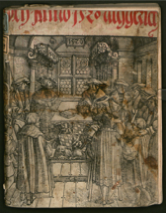
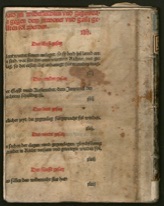
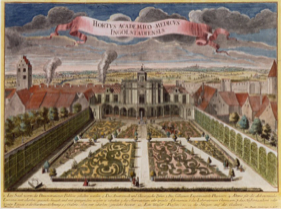
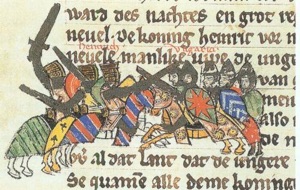
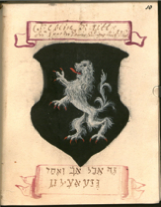
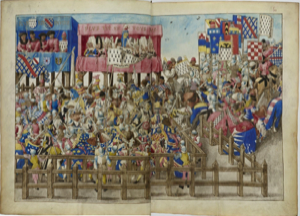
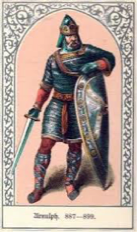
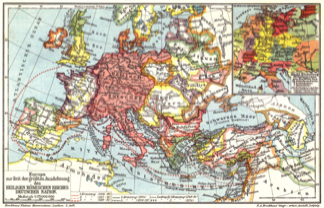
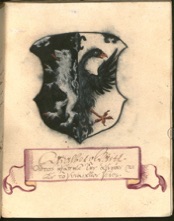
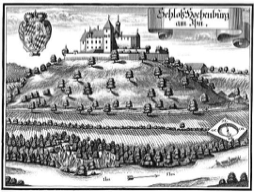
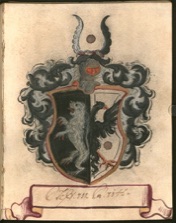

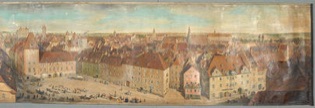

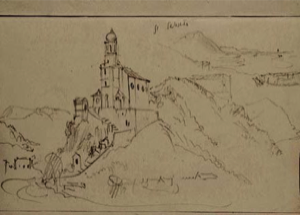
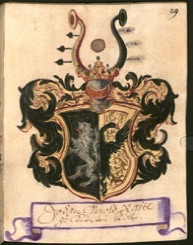

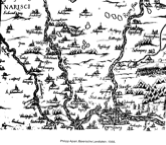
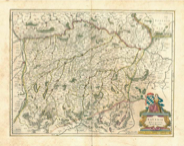
[Johan Arnold Raitt was] The stable master of His Princely Highness, the Duke Phillipp of Bavaria, Cardinal of the Holy Church and Bishop of Regensburg. [This is probably Philipp Wilhelm of Bavaria (1576-1598) Cardinal, also Prince-Bishop of Regensburg, son of William V, Duke of Bavaria from 1579-1597]
[Latin text - not yet translated. Apparently an entry given by Johann Arnold Raitt in 1598.
The mentioned knight Johann Arnold Raitt (Joannes Arnoldus de Raitt) was a student at Ingolstadt University in 1590 (reported in the “Memoria serenissimorum Ducum et Principum…” / page 29 / given by Hermann Anton Maria von Chlingensperg, printed in Ingolstadt in 1719). The entry above says that Johann Arnold Raitt wanted to “change his life to the better” and to “retire from the world and become a monk”.]
A knight without a castle,
A horseman without a horse,
A rich person without any money,
are fools in the eyes of the world.
Otherwise,
be fearful of the Lord and
avoid a sinful life.
Balthasar Raith, citizen and butcher in Neustadt near Abensberg, 1635.
I do not know how long I will live,
I do not know when I will die,
I do not know where I am going,
Why am I, nevertheless, in such
a good mood.
1676
Georg Raith, farmer and treasurer of the church in Groß Merringen.
[Raitt, George, owner of Hofmarch Podenstein, after legitimizing his nobility, it was confirmed to him on 30 April 1699 as “of Raittenstein”.]
Anna Raitt, wife of Jürgen Raitt,
In the year 1683
[Possibly Anna died in 1683]
[This is the last entry in the manuscript - the last page being from a judicial code which has nothing to do with the book itself.]
**********
As noted at the beginning of this page, there may be some doubt as to whether this manuscript about the Raitts in Bavaria is genuine - well, that is to say, the manuscript is certainly genuine and extant, but whether the contents are true is open to question. The German translator of the Latin text, who seems to be well-versed in ancient German documents and sources has made a number of comments on the authenticity of the document and I have elected to incorporate them into a blog entry so as to preserve the essence of the manuscript itself.
Johann Arnold Raitt arms
Knight of Kürnstein
He [Gabriel] was very sad because of the fire, [his castle was burned down] and he died in Regensburg in 1367. The holy Franciscan brothers at the Saint Salvator monastery in Regensburg buried his body at their monastery, because he was their benefactor and good friend. [The Franciscan monastery was founded in 1221 by the Bishop of Regensburg Konrad IV of Frontenhausen, Count Otto VIII of Bavaria, and King Henry VII.]
Tobias Raitt fought for the Emperor Maximilian [1459-1519] in the Battle of Dornach [on 22 July 1499], which the emperor lost badly. [A few Greek words in a scroll - not translated.]
Adam Raitt and Carl who is his son. Adam has given his son Christoph [whose son? Carl’s? Is this the same Christoph, book lover, and with the coat of arms] to the cathedral canon [possibly Regensburg Cathedral which opened in 1520], and he gave his son Carl, Junior, [ditto] to Ebel Hayset (?). And he has loaded up his castle with debts. Adam's wife is a maid for an animal skinner, and his son Carl is barely surviving.
Franz Raitt from Kürnstein, Elisabeth Zingl his legitimate wife. Hans Arnold, Simphorga, and Maria Ailia are his children.
Simon Raitt, who is the brother of Franz, is employed with the emperor's cavalry. He has two sons, Balthasar and Joseph. [It is not clear which emperor - Maximilliam who died in 1519 or his successor Charles V]
Do not punish anyone when you are angry, and do not make promises when you are drunk. Do not open your door to those who charm you, and do not lend your ears to the gossipers and chatterers. Always make an effort to gain the affection of good people, and do not pay attention to the hatred of the bad ones.
Hans Jacob von Closen [possibly the one dying in 1606 in Gern (Munich)]
Michael, Baron from […inchen]? and […]?
Hans Georg von Closen [perhaps the father or brother to Hans Jacob von Closen]
Gabriel Raitt arms
Stephan Raitt. Served for Friedrich von Österreich/Austria [1289 - 1330] and Ludwig von Bayern/Bavaria [1282-1347] and was killed near Esling [a farm in Bavaria, south of Regensburg].
Gabriel Raitt from Raittstein near Kürnstein. He served as a soldier for Duke Ludwig from Ingolstadt. When Duke Heinrich from Landsfurth wanted to occupy castle Wasserburg [on the river Inn in Upper Bavaria], Gabriel objected, and he threatened him with force. For this, the duke burned down his castle in Kürnstein on Wednesday after Sankt Thomas day, the twelfth day of prayer in the year 1366. His first wife was a Dolinger and the second wife was a Kirchel.
Go only to a rich man when he calls you,
Go to a poor man without being called.
Fugger, Baron of Kirchberg and Weißenhorn. [An ancient family - this one might be Sigmund Friedrich Fugger von Kirchberg und Weißenhorn who was bishop of Regensburg from 1598-1600. Possibly he wrote the lines above.]
Stephan Raitt arms
[Adalberd Raitt] went to Rome with Emperor Otto and Duke Heinrich of Bavaria to quell an uprising. [This may have been either Henry I or II, Duke of Bavaria, and Otto II (955-983) who made several excursions to Italy.] The foreigners [i.e. Italians] killed him in a battle; he had received nine wounds. He was not married, however, his brother [who was his brother?!] was married to Madlene Habsperger from Swabia [south west Germany including Baden-Württemberg], Yberachher from Sighartstein [in 1297 the court Sighartstein (near Salzburg, Austria) was given to the monastery at Raitenhaslach], and Elsbeth Holzapfel, a woman from the Rhineland. [Did Adalberd’s brother have children I wonder?]
Andre and Urban Raitt. Andre supported Emperor Konrad [possibly Conrad II [990-1039] at the court in his fight against Heinrich, Duke of Bavaria and Saxony. For this, the Emperor allowed him to build the castle Raittstein. His brother Urban was a personal guard for Duke Otto von Meran [1190-1234?], and his bearer of arms. The ten brothers [who were the others?!] owned the Kürstein [presumably Kürnstein] castle on the Inn river equally. [The Inn, 517 km long, has its source in the Swiss Alps near St Moritz and flows through Switzerland, Austria and Germany (Bavaria) entering the Danube at Passau.]
Copy
I, Heinrich, bishop of Regensburg, by the grace of God, as chairman, and Ludwig and Stephan (the Younger), counts in charge of the forests near Rhein, and dukes in Bavaria, by the grace of God, we have a document pertaining to the disagreements between our dear Stephan Raitt from Egkh, called the "Raittegker", on one hand, and Ulbricht Raitt from Kürnstein on the other hand. It concerns the origins of their ancestors, their coat of arms and shield, their helmet ornamentations and other decorations. They appeared before us, asking us to make a decision so that their heirs and descendants can go on without worrying about this issue. We looked at their document, which is about four hundred years old, and we interviewed them. We came to the honest conclusion that they - going back in time - come from the same blood and descend from the same family. They had the same shield, namely decorated with a white lion, and half a black eagle. When their parents divided their inheritance, one part of the family decorated their coat of arms with a helmet that had a white unicorn with a black horn and a yellow crest which was surrounded by red and white bands looking like a wreath.
After reflecting on all of this, we decided that everything should remain as it is. Each party has the permission to use either coat of arms as they please. And they should sit together, like their parents did, during knightly games and other honest activities. As far as the helmet decoration is concerned, we received enough reports telling us the Raitts always had a lion under the wings of an eagle on it. However, the other Raitts had the decoration of a horn. We concluded to leave everything as it is, and each party can carry their coat of arms without having to worry about it. We gave a document about this to each party. This happened in Regensburg in the year one thousand two hundred and ninety-two. St. Martin, the day of the holy evangelist. [10 November]
[Heinrich, Bishop of Regensburg, is likely to be Heinrich II von Rotteneck who was prince-bishop of Regensburg from 1277 until his death on 7 Aug 1296. Ludwig is likely to be Louis II (1229-1294), Duke of Bavaria and Count Palatine of the Rhine. Stephan the Younger is probably Stephen I (1271-1310) who was Duke of Lower Bavaria from 1290-1310). This implies, then, that the coat of arms dates from about 900 or just before. It is also interesting to note that in 1292, Sir Gervase de Rait and his brother Andrew were paying homage to Edward I in Scotland.]
Copy
In the Earldom of Falkenstein and Neuburg on the river Mangfall, old Lists of Transfer of Deeds tell us, that Jörg Raitt from Stein, who was also called the "Raittsteiner", and Albrecht Raitt from Egk/Egkh, who was also called "Raittegker", had a quarrel about the castle in Stein, namely the castle Raittstein near Kötzting. This ended up in a large fight. Jörg received the above mentioned castle in a lawful way, and a court document shows this. It was issued by the deputy of the ruler, Härdtli Puochberger, in Lower Bavaria in the year one thousand three hundred and one.The next day after Sankt Jürgen's/Sankt Georg's day of martyrdom [April 24]. The following persons were judges at the court: Mr. Ditrich Starzhausen, Mr. Ulrich Pfeffenhauer, Mr. Schwinkher from Gundlfink, Mr. Kunrath from Schwarzenburg, Mr. Sigfried from Rodenstein, Mr. Steffel from Auerberg, Mr. Albrecht and Mr. Fridrich from Lichtenberg. All of them are knights.
Copy
Ludwig, forever Roman emperor, by the grace of God, and ruler of the empire, announces openly with this letter that we honour our faithful Hans [Jörg] Raitt from Kürnstein and bestow on him the castle. He himself had claimed ownership all along, and his subjects, living in the area, had attested to it. Herewith, we assure him his rightful ownership. This month, we order all of the named officials to see to it that he keeps his homestead, and that no one takes it away from him. As documentation, this letter, adorned with our seal, should be given to him at the encampment in Mülldorf/Müllersdorf. In the year one thousand three hundred after the birth of Christ. Counting the nineteenth year, and the fifth year of our empire.
[Presumably this is Louis IV (1282-1347), called the Bavarian, of the house of Wittelsbach, was King of Germany (King of the Romans) from 1314, King of Italy from 1327, and Holy Roman Emperor from 1328. Louis IV was Duke of Upper Bavaria from 1294 /1301, served as Margrave of Brandenburg until 1323 and as Count Palatine of the Rhine until 1329, and became Duke of Lower Bavaria in 1340.]
[Latin text not yet translated - apparently an entry written by Dr.iur. Johann Conrad Hörwarth.]
[Hans Conrad Hörwarth von Hohenburg was a jurist being active during the 1650s and 1660s (a lawsuit file on one of his affairs is kept in the Bavarian state archives of Landshut). He lived in Neufahrn castle, some 35 km south of Regensburg.]
[Latin text not yet translated. Just four lines without date, given by Matthias the abbot in Raitenhaslach - a cistercian abbey, some 120 km SE from Regensburg, at the Austrian border - probably Matthias Stoßberger (abbot at least since 1591, died in 1601)]
Adalberd Raitt arms
[Greek or Hebrew text - mentions the word purity]
Hildust Raitt had a man to man fight with Gernold Hofer from Lobenstein [Bavaria, their castle is a ruin]. [A few untranslatable words]. He received the maiden Agnes from Etlingen as his wife. [This is probably Ettlingen in Baden-Württemberg.]
A person, who not only gives us a good example of how to lead a pious life, but who also gives us a good example of how to die blessedly, only such a person is a blessedly happy human being.
Hans Sigmund from Degenberg [Lower Bavaria, died 1602]
Baron Carl Kräegl from Fürth
Do not wear garments that are too flashy, because this is a sign that you have a disposition like a vain woman. Do not rush into agreeing to shelter a stranger, but once you have done this, do not abandon him lightly, and always talk about him in a nice way.
Wolf Moritz from Rohrbach [named in a document in 1591 in connection with Ingolstadt. This Rohrbach is probably the one in Bavaria]
Hans Adam Egkh from Rehlingen [Lower Saxony]
Hans Sigmund from Münchau and Laberweinting. [both in Bavaria]
[Who these people are and why they are mentioned in this context is unclear. Perhaps they wrote the lines quoted.]
Cölvlin Raitt - served for the bishop of [? - indecipherable]
[This coat of arms bears a Hebrew "motto". My Latin translator told me he asked the rabbi of the Jewish community in Koblenz about it. He was told that it seemed to him like a cut-off text, probably a beginning of a sentence copied from another source. The first line contains the Hebrew word for “feast” or “banquet”. The second line begins with the Hebrew word for “noble clan”. However, the two lines did not make any sense to the rabbi, and there is no reason why a Christian knight should take a Hebrew motto since in the 17th century the Jews were considered as heretics and “enemies of the true belief”.]
Ragado Raitt was Emperor Karl's [Charles the Great, Charlemagne, born 2 April 742, died 28 Jan 1814 - crowned Emperor in 800] guild master in Bavaria in the year 803 after the birth of Christ, and the brothers [which brothers?] from Messelhausen [now located in Baden-Württemberg] married off their sister to him. [I am not sure of the meaning of guild master since I thought guilds (with their apprentices, journeymen and masters in various trades) did not come into being until much later. Maybe he was in charge of all the guilds in existence under Charlemagne.]
Arno Raitt. He married Else Weishund, who is the sister of the abbot from Weldeburg [place not located. It might be Waldenburg in Baden-Württemberg.]
Arno and Cunz, who is Arno's brother, built their castle in Stein near Kötzting [in Bavaria near the Czech border], and they named the castle after their name: "Raittenstein".
Ulrich Raitt, who is the father, and Günther and Hillbrand are his sons. They served as soldiers in the army of Emperor Arnulf [von Kärnten - Arnulf of Carinthia was the Carolingian King of East Francia from 887, the disputed King of Italy from 894 and the disputed Holy Roman Emperor from 22 February 896 until his death at Regensburg, Bavaria on 8 December 899], and they participated in the battle against the Normans/Vikings in the year 891 after the birth of Christ [this battle was fought in September 891 at Leuven in Flanders and Arnulf and his men successfully repulsed an invasion by the Normans (Northmen or Vikings) thus ending their incursions in the Low Countries - Holland and Belgium.] Ulrich died shortly afterwards at his farmstead in Haslach [there are two places called Haslach - one in Baden-Württemberg, south west Germany and one in Upper Austria. Interestingly, there was also a church or cloister at Raittenhaslach, near Burghausen on the Germany/Austrian border.]
Hillebrandt Raitt participated in the Emperor's march towards Rome [Arnulf’s first campaign in Italy was in January 894 when he was crowned King of Italy and his second in October 895. He was crowned Emperor on 22 February 896.] His wife, Dietwind or Wiltraut, was well liked by the duchess. When he died, the Emperor honoured him with a letter, which is copied here. [This letter was written in Latin.]
Copy
This copy is literally corresponding with the original document.
Arnolf, by God's favour and grace Emperor. If we observe our forefathers' customs and give support to those being deserving on behalf of us and the Empire, we believe without any doubt that this is useful for us, for the stability of the Empire (which has been erected for us by the dispensation of Providence) and in order to achieve the reward of everlasting right. Therefore all our industrious subjects in present and future times may come to know, that I confer the title of infantry captain upon the brave man and decent knight Hildebrand Raitt, since he was one of the first men climbing the city wall when I besieged and conquered the city [i.e. Rome, January 896] by armed hands, and I rank him in the highest noblemen in the Roman Empire and in our kingdoms [i.e. Ostfranken = Germany 887-899 and Italy 894-899.] I hereby order that the mentioned Hildebrand Raitt and all his legitimate descendants may be acknowledged and considered as noblemen. By our high authority we grant as well, that the sign of the white lion - being bestowed due to the outstanding valour in warfare and being an ornament [decoration] for Hildebrand's ancestors for many years - may be accompanied by a divided eagle as an eternal witness of the inherited virtue and the merits. It is declared by oath that Hildebrand Raitt bears such signs of nobility, privileges and prerogatives, as well as all legitimate descendants on the paternal line, for ever. For the purpose that this command [our grant] shall obtain the highest steadiness and validity, we personally acknowledged it below and we ordered that it shall be sealed with our signet-ring.
Sign [monogram] of the august Emperor Arnolf; the notary Engilbero; besides the chancellor Wichingo. Given on the 14th calends of October [i.e. 16 September - calends is the first day of the month with Roman dating reckoning backwards] in the year of the Lord's incarnation 898, Indiction VI, in the 11th year of Arnolf's royalty, but in the 3rd year as an Emperor; given in Ratensdorff [Regensburg], in God's name, Amen.
Cölvlin Raitt arms
After the battle, the Emperor honoured the noble participants by providing musical and other entertainment. However, he was contemplating how he could show his honoured guests more fun. And that’s when he came up with the idea of a new knightly game, called a tournament, which was new to Germany. The reason, why one started these tournaments, was that the young nobleman could train in a cheerful surrounding for serious fights in a battle. For this reason and other reasons, which would take too much time to tell you, the game was started in the German Empire in the town of Merseburg. This was the first knightly tournament, and its beginning was in the year nine hundred and thirty-eight. [Heinrich did not live to see it - he died on 2 July 936. The first tournaments - basically knight training events for warfare - in England were held at the end of the 11th century. By 1170 western Europe had a craze for knightly tournaments - riotous, chaotic affairs tantamount to large-scale war games played out by teams of mounted knights across great swathes of territory often more than 30 miles wide - unlike the orderly, mannered jousts of the later Middle Ages. The greatest tournament of the 12th century was organized at Lagny-sur-Marne to the east of Paris during the occasion of the coronation of Philip II on 1 November 1179 when some 3000 leading knights took part.]
Preface
Everyone knows the entire human mankind descended from Adam, our progenitor. At that time, everyone was on equal footing, no one was regarded as being more noble or wealthier than the other person. Everyone was equal, everyone was made out of flesh and blood and came from the same soil. Everyone knew this and accepted it.
However, as far as the inner qualities of human beings are concerned, like our attitude, common sense, strength of will, memory, and the strength of our soul, qualities that distinguish human beings from the mindless animals, there is a big difference from one human being to another. Some human beings are more inclined to live honourable, decent, respectable, courageous lives than others. Therefore, we honour those who distinguish themselves because of their honest and courageous demeanour, and we bestow on them a noble title.
A good example of this happened right at the beginning of the world, as one can read in Genesis, Chapter Nine. The beginning of nobility started with Noah. He fathered three sons, namely Shem, Ham and Japheth. And Noah, who had planted a vineyard, got drunk and was lying exposed in his tent when his youngest son Ham saw him. Ham left his father uncovered for his two brothers to see. However, those two, being respectful, averted their faces when they covered their father, and they did not see his nakedness. When Noah awoke and was aware of what had happened, he cursed Canaan, who was Ham's son, because of his father's dreadful, uncalled for deed, and he told him that Canaan and his offsprings will be servants from now on. Shem and Japheth, who had shown such noble attitude, received a noble title from their father, and they were now the masters over their own brother.
In the history of the Roman people we can find numerous examples. Historians wrote down the names for eternal remembrance of the citizens and comrades, who were honoured highly in a noble fashion and mentioned honourably, because they had risked their lives while serving their fatherland admirably. There is Horatius Cocles, who defended a bridge [the Pons Sublicius across the river Tiber, leading towards Rome] all by himself against the enemies. [in the year 507 BC - the enemies being the soldiers of Porsenna, a king of Etruria, who was attacking Rome]. Equally courageous was the person who stabbed King Porsenna’s overseer when he was with him, because he was his enemy. Each of them were honoured with a monument. [Mutius, an Etrurian peasant was resolved to kill Porsenna to rid his land of this oppressor. However, he mistook Porsenna’s secretary who was standing by his side for the king and stabbed him through the heart. His actions and subsequent words impressed the the king and he was set free].
In addition, the Romans elected courageous, honest and esteemed men as mayors, dictators and treasurers. And it is because of these esteemed positions, which are the origins of the Princes and Dukes, that these men were bestowed with noble titles and authority, and it did not matter what family background they had. The nobility has always enjoyed the respect of everyone - going back to ancient times - during times of peace and of war. Therefore, because of this noble custom, each elected Roman Emperor bestowed certain privileges on those who had behaved honestly and courageously in times of war and otherwise. He honoured them with a shield, helmet and crest, and they could participate in knightly tournaments. He gave them a noble title when they behaved in an honourable fashion and performed good deeds, and he encouraged everyone to lead their lives with honour and to perform good deeds.
Therefore, these coat of arms and the family names and the inscriptions, as well as other letters, have been collected in this booklet for all the descendants belonging to the noble and ancient Raitt family, who also called themselves Ratt years ago. The reason for this is to motivate the descendants to follow in the footsteps of their honest and brave forefathers.
Eneas Silnius [possibly the poet and orator, author of Miserie curialium, later Pope Pius II from 1458-1464] writes that they became honour guards many years ago. They had to visit dukes and esteemed men all over the territories. They received letters, valuable jewellery and other treasures. They had the right to live splendidly. They were protected and could punish those severely who would cast doubt on their profession, because their mission was to protect and fight for the sanctity of marriage, moral values and decency among princes, nobles, knights and servants. They knew how to deal with nobility, esteemed families, pious people and dukes. They saw to it that these people led a life without blemish. They had to blazon their coat of arms with nice words and embellishments.
They had to praise them when they performed good deeds, and they had to spread the word about it. They had to admonish dukes and other noble people when they were lacking in virtues and lived a life unbefitting for a noble person. Because discipline, honourable behaviour and decency are dying out, and bad manners are taking over, the honour guards should take a stand against this, and they should punish everyone who is guilty according to the deed committed so that noble persons conduct themselves like they are supposed to. Therefore, a long time ago, the honour guards were seen at the residences of kings and princes near and far away so that the higher and lower nobility would behave in an honourable fashion and love this more than silver and gold. But, nowadays, everyone shies away from behaving in a noble fashion, and people do not fear the honour guards anymore. The Emperor is left standing all alone and therefore [? - unreadable.] Finally, I like to say that the situation described above is handled only by the Emperor's honour guards.
The Origins of the Honourable Knightly Games, called Tournaments
In the year nine hundred and thirty-five, after the birth of Christ, when Emperor Heinrich [about 876 - 936] reigned, who was the emperor of the Holy Roman Empire, and he was Duke of Saxony. [Heinrich - Henry the Fowler - was not actually the Holy Roman Emperor, but rather King of Germany (and East Francia). His son Otto became Emperor.] He brought honour to his name, because he was courageous when he fought the Hungarians, who were against the Christians, and whose tyrannical ways the whole world was aware of. They threatened the land and the people of the Emperor Heinrich, and they threatened the Holy Roman Empire. One can read in the history books, where it is written in detail, that the Emperor rallied together everyone living in the Roman Empire, no matter if they were of equal status or not, and the Hungarians were defeated. The army was gathered together in sixty-nine days, and the battle was in an area outside the city of Merseburg, Saxony. [The Magyars (Hungarians), Eurasian nomads who had originally served as mercenaries under Emperor Arnulf, began to campaign in the Kingdom of Italy and East Francia after his death in 899. In 906 they broke up Great Moravia and one year later destroyed a Bavarian army at the Battle of Pressburg. The Battle of Riade or Battle of Merseburg was fought between the troops of East Francia under king Henry I and the Magyars at an unidentified location in northern Thuringia along the river Unstrut on 15 March 933. The battle was precipitated by the decision of the Synod of Erfurt to stop paying an annual tribute to the Magyars in 932.]
For the book cover the leaves A1 and A8 of the following parchment printout have been used: Judicial Code for the Dukedom of Upper and Lower Bavaria. Written in the year 1520. Munich 1520. See: 2° L. impr. m. 43. [Parchment was expensive and people re-used it, like here as a book cover.]
Following a few blank pages, there is then, in Latin, a poem of Homer given by the president of Ingolstadt University. [The University of Ingolstadt, south west of Regensburg, in the centre of Bavaria was founded in 1472 by Louis the Rich, the Duke of Bavaria at the time, and its first Chancellor was the Bishop of Eichstätt. It consisted of five faculties: humanities, sciences, theology, law and medicine. Its chief goal was the propagation of the Christian (Catholic) faith. The university was closed in May 1800 by the Prince-elector Maximilian IV (later Maximilian I, King of Bavaria).]
